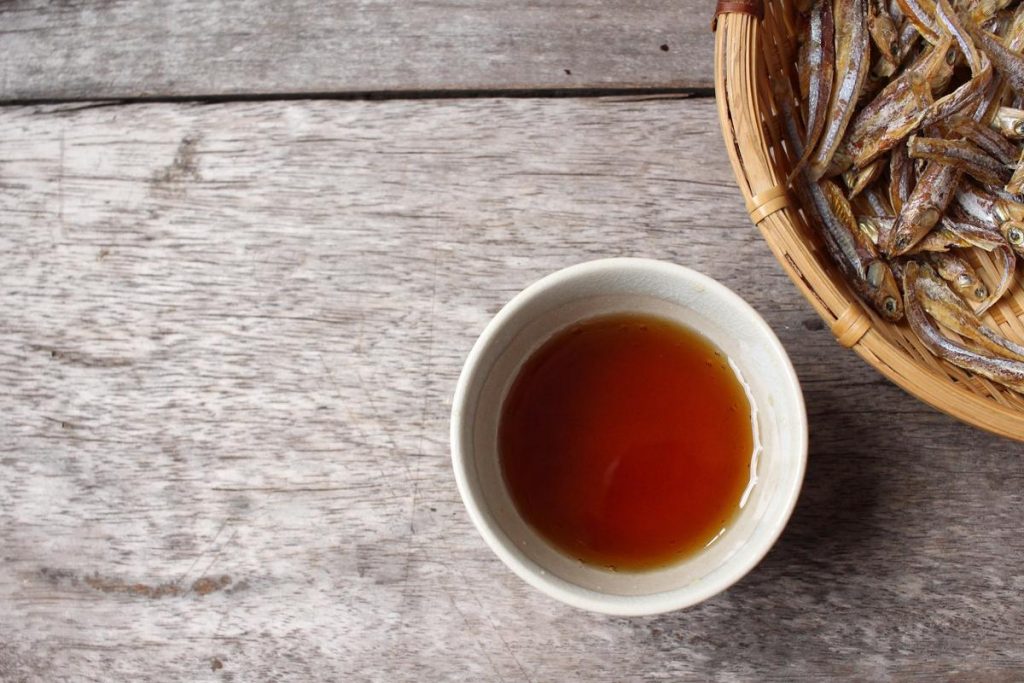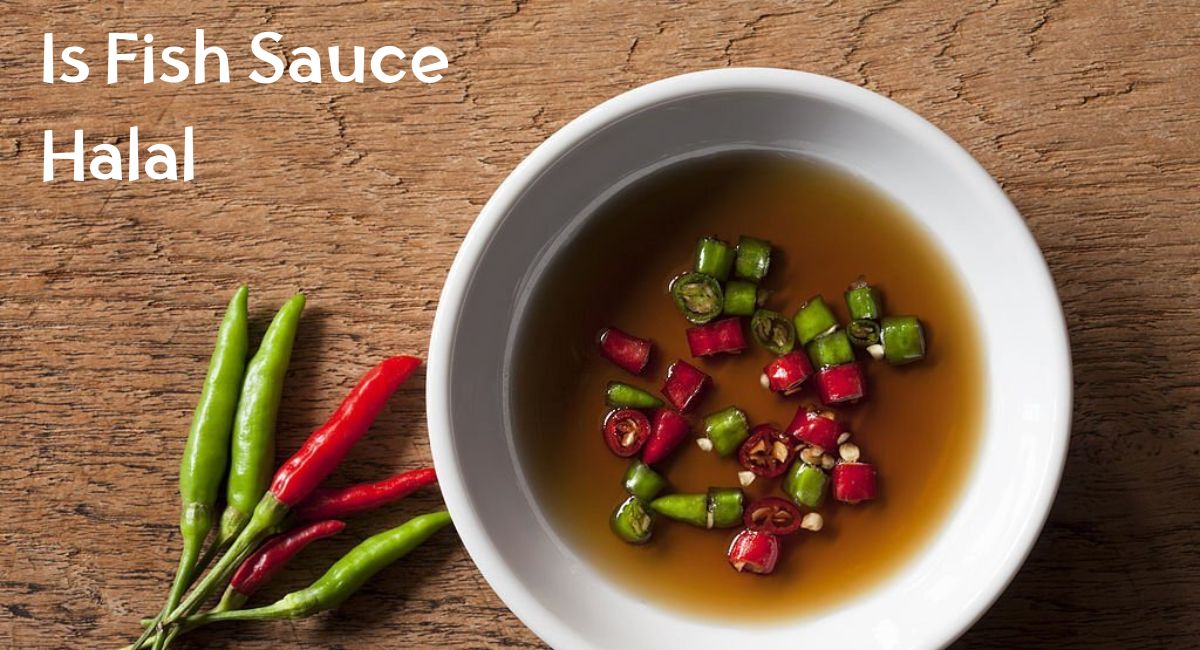Fish sauce, a pungent and savory condiment, has been a staple in many Southeast Asian cuisines for centuries. Derived from the fermentation of fish, it adds a unique and distinctive flavor to various dishes. However, for those who adhere to Islamic dietary laws, the question arises: Is fish sauce halal?
In this article, we will explore the intricacies of fish sauce production, the key ingredients involved, and the processes employed by manufacturers. We will also delve into the critical considerations that determine the halal status of fish sauce, shedding light on the various perspectives and scholarly opinions within the Islamic community.
Is Fish Sauce Halal
The majority of seafood, including fish, is considered halal by the four major schools of Islamic thought. However, the Hanafi school of thought considers fish to be halal, while other seafood, such as crabs, may be classified as makruh (disliked) or haram (forbidden). The Quranic verse from Surah al-Ma’idah (5: 96) is often referred to by scholars to support the permissibility of seafood consumption.
Lawful to you is the game of the sea and its food as provision for you and the travelers
This verse discusses the permissibility of consuming seafood and its food, emphasizing that it is permissible to eat and benefit from the game of the sea while traveling or settled.
Therefore, keeping in line with this belief, any fish sauce made with fishes like bass, cod, tuna, etc. will be considered halal in all schools of thought. However, fish sauce made with seafood like shrimp, prawns, lobsters, etc. will be considered haram in Hanafi school of thought and halal in other schools.
It is also important to mention here that the sauce should not contain any other haram ingredients like pork and alcohol. The presence of any haram ingredient will make fish sauce haram even if it is made with a halal fish.
Consulting with local authorities regarding the halal-haram status is advisable to ensure compliance with Islamic dietary guidelines and regulations.
Is Thai Fish Sauce Halal

Thai fish sauce is a staple ingredient in Thai cuisine and much of Asian cuisine. It is a rich, translucent reddish-golden brown color and has a salty, fishy flavor. It is often used as a marinade for fish and meat, as well as a condiment.
The sauce is typically made from fermented anchovies, salt, and water. Here are some common ingredients found in Thai fish sauce:
- Anchovies: The main ingredient in fish sauce is usually anchovies, which are small, oily fish that are salted and fermented to create the sauce.
- Salt: Salt is added to the anchovies to help with the fermentation process and to preserve the fish sauce.
- Water: Water is added to the mixture to help extract the flavor from the anchovies and to dilute the sauce.
- Sugar: Some recipes may call for sugar to balance out the salty and fishy flavors of the sauce.
- Chili peppers: Chili peppers are often added to fish sauce to give it a spicy kick.
- Garlic: Garlic is a common ingredient in Thai cuisine and is often added to fish sauce for flavor.
- Lime juice: Lime juice is added to fish sauce to give it a tangy flavor and to balance out the saltiness.
It’s important to note that different brands and recipes may have slightly different ingredients and ratios, so it’s always a good idea to check the label or recipe before using.
While traditional Thai fish sauce may not inherently contain haram ingredients, it is still essential to verify its halal status through proper certification. Checking the packaging or contacting the manufacturer to inquire about their halal certification is advisable.
Is Blue Dragon Fish Sauce Halal
Blue Dragon Fish Sauce is a popular condiment used in various cuisines, particularly in Southeast Asian cooking. It is a versatile and savory sauce that adds richness and depth of flavor to dishes. It has a bold and pungent flavor profile, with a balance of saltiness and slight sweetness. It adds a depth of flavor to dishes without overpowering the other ingredients. The sauce enhances the overall taste of a dish, making it a staple in many Asian cuisines.
For individuals following a Halal diet, understanding the ingredients and production process is crucial. Blue Dragon Fish Sauce is made from anchovies, a commonly used fish in halal cuisine. Anchovies are generally considered halal by Islamic scholars, provided that they are processed in a manner that complies with halal standards.
However, Blue Dragon Fish Sauce does not have an official Halal certification. While the sauce is made from anchovies, which are generally considered halal, it’s important to note that the absence of a halal certification means that the production process and ingredients have not been verified and approved by a recognized halal certification body.
In conclusion, the halal status of Blue Dragon fish sauce ultimately depends on individual beliefs and preferences. Muslim consumers seeking a halal-certified fish sauce may need to explore alternative brands or look for specific certifications that align with their dietary requirements. It’s always advisable to carefully read product labels and seek guidance from authorized halal certification bodies to ensure compliance with your specific dietary restrictions.
What is Fish Sauce

Fish sauce is a condiment that has a long history and is commonly used in Southeast Asian and East Asian cuisines. It is made from fermented fish and salt, resulting in a savory and umami-rich flavor.
The origins of fish sauce can be traced back to ancient times. The Greeks and Romans were early producers and consumers of fish sauce. The Greeks produced a fish sauce called “gàros” along the Black Sea coastline, fermenting small fish with salt to create an amber-colored liquid.
The Romans also had their own version of fish sauce known as “garum.” It was one of the most popular ingredients in Roman cuisine and was made by fermenting fish or fish entrails and salt. The Romans used garum extensively and even exported it throughout their empire.
Fish sauce continued to be used in various forms and spread to different regions. It is believed that fish sauce may have been introduced to Asia via the Silk Road. Traders likely brought fish sauce from Vietnam to southeastern China, and the British encountered it during their travels in Southeast Asia, leading to their attempts to replicate the sauce.
Over time, fish sauce became an essential ingredient in the cuisines of countries such as Myanmar, Cambodia, Laos, Philippines, Thailand, and Vietnam.
Today, fish sauce remains a staple in Southeast Asian and East Asian cooking. It is used in various dishes and sauces, adding depth of flavor and enhancing the savory profile of the cuisine. Vietnamese fish sauce, known as “nuoc mam,” is particularly famous and widely used in Vietnamese cuisine.
The history of fish sauce highlights its long-standing presence in culinary traditions, from ancient Greece and Rome to its prominence in Southeast Asia today. Its unique flavor and contribution to umami continue to make it a popular and essential ingredient in many dishes.
What Does Fish Sauce Taste Like
Fish sauce has a unique taste that can be described as salty, savory, and earthy with hints of umami. It has a complex flavor profile that combines salty and tangy notes with a deep, fermented taste. Some people also perceive a slight sweetness in fish sauce, while others detect a subtle fishiness or funkiness in its aroma and taste.
The flavor of fish sauce can vary slightly depending on the brand and the specific region where it is made. Different types of fish, such as anchovies or mackerel, can be used in the production of fish sauce, contributing to slight variations in flavor. Additionally, the fermentation process and the length of time the fish is fermented can influence the taste.
Fish sauce is commonly used as a seasoning and flavor enhancer in various dishes, particularly in Southeast Asian cuisines such as Thai and Vietnamese. It adds depth and complexity to stir-fries, soups, marinades, and dipping sauces, imparting a distinct umami flavor. However, it is worth noting that fish sauce should be used in moderation, as its taste can be quite intense, and a little goes a long way in enhancing the flavors of a dish.
Is Fish Sauce Low FODMAP
Fish sauce can be considered low FODMAP in normal serving sizes. The Monash University FODMAP Diet App categorizes fish sauce as low FODMAP. However, it’s important to note that the FODMAP content can vary among different brands and types of fish sauce. It’s recommended to check the specific brand and serving size to ensure it aligns with the low FODMAP diet guidelines.
FODMAPs (fermentable oligosaccharides, disaccharides, monosaccharides, and polyols) are a group of carbohydrates that can trigger digestive symptoms in some individuals, particularly those with irritable bowel syndrome (IBS). The low FODMAP diet is a dietary approach designed to help manage IBS symptoms by reducing the intake of certain FODMAPs.
If you are following a low FODMAP diet, it’s advisable to choose fish sauce brands that do not contain high FODMAP ingredients such as onion or garlic. Reading the labels and selecting products specifically labeled as low FODMAP or suitable for the diet can be helpful.
Types of Fish Sauce

Fish sauce comes in various types and variations, each with its own unique characteristics. Here are some notable types of fish sauce:
- Vietnamese Fish Sauce (Nước Mắm): Vietnamese fish sauce is known for its clear amber color and rich umami flavor. It is commonly made from anchovies and is a staple ingredient in Vietnamese cuisine, used in dishes like pho, dipping sauces, and marinades.
- Thai Fish Sauce (Nam Pla): Thai fish sauce is a key ingredient in Thai cooking, adding a distinct salty and savory flavor to dishes. It is typically made from anchovies and has a reddish-brown color. Thai fish sauce is used in various Thai dishes, such as pad Thai, green curry, and tom yum soup.
- Filipino Fish Sauce (Patis, Bagoóng): Filipino cuisine incorporates fish sauce in different forms. Patis is a liquid fish sauce similar to Vietnamese and Thai varieties, while bagoóng is a fermented fish or shrimp paste that adds a unique flavor to Filipino dishes.
- Indonesian Fish Sauce (Kecap Ikan): Indonesian fish sauce, also known as kecap ikan, is commonly used in Indonesian cuisine. It is made from fermented anchovies or other small fish, and it has a dark color and robust flavor. Kecap ikan is often used in Indonesian stir-fries, marinades, and dipping sauces.
- Chinese Fish Sauce: Fish sauce has ancient origins in China, and it is still used in certain Chinese regional cuisines. In Chinese cooking, fish sauce can be made from various fish, such as anchovies or other small fish. It is used to enhance the flavors of dishes like stir-fries, braises, and noodle soups.
These are just a few examples of the types of fish sauce found in different culinary traditions. Each type has its own nuances and is used in specific regional dishes. It’s important to note that the flavor and characteristics of fish sauce can vary among brands and even within regions. Exploring different types of fish sauce can add depth and complexity to your cooking, allowing you to discover new flavors and culinary experiences.
What is Fish Sauce Made of
Fish sauce is a condiment made from the fermentation of fish and salt. While there may be variations in the specific ingredients and production methods among different brands and regions, the basic components remain consistent. Here’s what fish sauce is typically made of:
- Fish: The primary ingredient in fish sauce is fish, usually small, oily fish such as anchovies, mackerel, or shrimp. The fish undergoes fermentation, which contributes to the unique flavor of the sauce.
- Salt: Salt is an essential component of fish sauce. It helps preserve the fish and facilitates the fermentation process. The salt draws out the moisture from the fish, allowing beneficial bacteria to break down the proteins and convert them into flavorful compounds.
Which Fishes Are Used in Fish Sauce

Fish sauce is made by fermenting fish with sea salt, and it can be made from various kinds of fish. Fish with high oil content are preferred for making fish sauce, as they provide more flavor and richness to the sauce. The specific fish used can vary depending on the region and the recipe.
Some commonly used fish for making fish sauce include:
- Anchovies: Anchovies are a popular choice for fish sauce production, especially in Southeast Asian cuisines. They have a strong flavor and are often used in combination with other fish to create a balanced sauce.
- Mackerel: Mackerel is another fish commonly used in fish sauce production. It has a high oil content and adds depth of flavor to the sauce.
- Shrimp: In some fish sauce recipes, shrimp or a combination of shrimp and fish are used. Shrimp-based fish sauces are popular in certain regions, such as in the Philippines where it is known as “bagoóng”.
- Various other small fish: Depending on the local traditions and availability, other small fish may be used for making fish sauce. These can include sardines, herring, or other small, oily fish.
It’s important to note that different fish sauces can have unique flavor profiles and aromas based on the type of fish used, the fermentation process, and regional variations. Fish sauce production techniques can differ across cultures and even among individual brands, resulting in variations in taste and quality.
How is Fish Sauce Made
Fish sauce is typically made through a fermentation process that involves fish and salt. The exact details of fish sauce production can vary, but here is a general overview of how fish sauce is made:
- Raw Material Selection: Fresh fish, often small and oily fish like anchovies or mackerel, are chosen as the main ingredient. The fish should be of good quality to ensure a high-quality fish sauce.
- Mixing Fish and Salt: The selected fish are mixed with salt at a specific ratio. The salt helps preserve the fish and initiates the fermentation process. The fish and salt mixture is thoroughly combined.
- Fermentation: The fish and salt mixture is placed in fermentation tanks or containers. The fermentation process takes place over a period of several months to a year or more. During fermentation, enzymes and bacteria naturally present on the fish break down the proteins and convert them into flavorful compounds. This process creates the characteristic savory and umami flavors of fish sauce.
- Aging: After the initial fermentation period, the liquid containing fish extract is obtained. The liquid is strained or filtered to remove any solid particles. Some producers may choose to age the fish sauce further to enhance its flavor and complexity.
- Filtration and Bottling: The fermented fish sauce goes through a filtration process to remove any remaining impurities and achieve a clear liquid. It is then bottled for distribution and consumption.
It’s important to note that fish sauce production methods may vary across different countries and brands. Different fish species, ratios of fish to salt, fermentation times, and additional ingredients like sugar or other flavorings can influence the taste and aroma of the final product.
Fish Sauce Benefits
Fish sauce offers several benefits that contribute to its popularity as a condiment and ingredient in various cuisines. Here are some of the potential benefits associated with fish sauce:
- Nutrient Content: Fish sauce contains nutrients and natural antioxidants that contribute to overall well-being. It is packed with essential amino acids, such as valine, isoleucine, phenylalanine, methionine, and lysine, which play important roles in the body. It also provides minerals like calcium, magnesium, iron, phosphorus, and potassium, as well as vitamins B12, D, and A.
- Umami Flavor: Fish sauce adds a savory umami taste to dishes, enhancing their overall flavor profile. It can be a flavorful alternative to high-sodium condiments, such as soy sauce, while still providing a satisfying taste.
- Lower Sodium Option: In a study published in the Journal of Food Science, it was found that using fish sauce as a partial salt substitute in various recipes can reduce the sodium chloride levels by 10 to 25 percent without compromising the umami effect and perceived saltiness. This can be beneficial for individuals who are watching their sodium intake for health reasons.
- Sodium Reduction: Fish sauce can be a healthier way to get your salt fix compared to regular table salt. A study published in the Journal of Food Science found that adding fish sauce as a partial salt substitute to various recipes reduced the sodium chloride levels by 10 to 25 percent without compromising taste.
- Omega-3 Fatty Acids: Some variations of fish sauce, especially those made with fish like anchovies, mackerel, or salmon, can contain omega-3 fatty acids. These essential fats are known for their potential benefits in heart health, brain function, inflammation reduction, and eye health.
While fish sauce offers potential benefits, it’s important to consume it in moderation and be mindful of personal dietary needs and preferences. Excessive consumption may lead to digestive issues due to the presence of certain amino acids.
How to Use Fish Sauce

Fish sauce is a popular condiment used in various Southeast Asian and East Asian cuisines, including Myanmar, Cambodia, Laos, the Philippines, Thailand, and Vietnam. It is a flavorful and savory ingredient that adds depth and umami to dishes. Here’s how to use fish sauce effectively:
- As a marinade: Fish sauce makes an excellent marinade for meats, seafood, and vegetables. Combine fish sauce with other ingredients like lime juice, garlic, ginger, and spices to create a flavorful marinade. Allow the food to marinate for at least 30 minutes or longer to absorb the flavors before cooking.
- In dipping sauces: Fish sauce is a key component in many dipping sauces. Combine it with ingredients like lime juice, sugar, garlic, chili, and herbs to create a tangy and savory dipping sauce for spring rolls, dumplings, grilled meats, or vegetables.
- In dressings and vinaigrettes: Add a splash of fish sauce to your salad dressings or vinaigrettes to enhance the savory flavors. It pairs well with ingredients like citrus juices, vinegar, sesame oil, and herbs, adding depth and complexity to your salads.
- In soups and stews: Fish sauce can be used to enhance the flavor of soups and stews. Add it to broths, stocks, or slow-cooked dishes to deepen the umami taste. Be mindful of the saltiness of fish sauce and adjust the overall salt content accordingly.
- In stir-fries and noodle dishes: Incorporate fish sauce into stir-fries and noodle dishes for a savory boost. It works well with a variety of proteins, vegetables, and noodles. Add it during the cooking process or as a finishing touch to enhance the overall flavor.
- As a seasoning: Fish sauce can be used as a seasoning agent in various dishes, similar to how salt or soy sauce is used. Add a small amount to balance and enhance the flavors of your dishes, such as curries, fried rice, or sautéed vegetables.
- In condiments and sauces: Fish sauce can serve as a base for homemade condiments like salad dressings, mayonnaise, or barbecue sauces. It adds depth and complexity to the overall flavor profile of the condiments.
- In non-Asian cooking: Fish sauce can be used creatively in non-Asian dishes to add a unique umami flavor. It works well in braised dishes, salad dressings, roasted vegetables, and even chicken stock, providing a savory boost to the overall taste.
Remember to start with a small amount of fish sauce and adjust according to your taste preferences. It is a potent ingredient, so a little goes a long way. Additionally, different brands of fish sauce may vary in flavor intensity, so it’s essential to taste and adjust accordingly.
Searching for information on the halal status of sauces with a salty, umami taste akin to fish sauce? Explore these articles
Is Soy Sauce Halal: Dive into the world of condiments as we explore the halal status of soy sauce. Uncover the key considerations and guidelines for determining whether this savory staple aligns with your dietary preferences.
Is Oyster Sauce Haram: Join us on a flavorful journey as we scrutinize the halal status of oyster sauce. Learn about the ingredients and production processes that influence the permissibility of this umami-rich condiment.
Is Worcestershire Sauce Haram: Unravel the mysteries of Worcestershire sauce as we unravel its halal credentials. Explore the complex blend of flavors in this condiment and determine whether it aligns with your dietary preferences.
Is Hoisin Sauce Haram: Embark on a taste adventure as we investigate the halal nature of hoisin sauce. Dive into the world of Chinese cuisine and uncover whether this sweet and savory condiment is a match for your halal diet.






